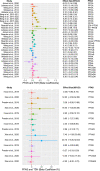A pathway level analysis of PFAS exposure and risk of gestational diabetes mellitus
- PMID: 34022907
- PMCID: PMC8141246
- DOI: 10.1186/s12940-021-00740-z
A pathway level analysis of PFAS exposure and risk of gestational diabetes mellitus
Abstract
Per- and polyfluoroalkyl substances (PFAS) have been found to be associated with gestational diabetes mellitus (GDM) development, a maternal health disorder in pregnancy with negative effects that can extend beyond pregnancy. Studies that report on this association are difficult to summarize due to weak associations and wide confidence intervals. One way to advance this field is to sharpen the biologic theory on a causal pathway behind this association, and to measure it directly by way of molecular biomarkers. The aim of this review is to summarize the literature that supports a novel pathway between PFAS exposure and GDM development. Epidemiological studies demonstrate a clear association of biomarkers of thyroid hormones and glucose metabolism with GDM development. We report biologic plausibility and epidemiologic evidence that PFAS dysregulation of maternal thyroid hormones and thyrotropin (TSH) may disrupt glucose homeostasis, increasing the risk of GDM. Overall, epidemiological studies demonstrate that PFAS were positively associated with TSH and negatively with triiodothyronine (T3) and thyroxine (T4). PFAS were generally positively associated with glucose and insulin levels in pregnancy. We propose dysregulation of thyroid function and glucose metabolism may be a critical and missing component in the accurate estimation of PFAS on the risk of GDM.
Keywords: Gestational diabetes mellitus; Glucose metabolism; PFAS; Thyroid hormones.
Conflict of interest statement
The authors declare that they have no competing interests.
Figures



References
-
- Sunderland EM, Hu XC, Dassuncao C, Tokranov AK, Wagner CC, Allen JG. A review of the pathways of human exposure to poly- and perfluoroalkyl substances (PFASs) and present understanding of health effects. J Expo Sci Environ Epidemiol. 2019;29(2):131–147. doi: 10.1038/s41370-018-0094-1. - DOI - PMC - PubMed
-
- Bjerregaard-Olesen C, Bossi R, Liew Z, Long M, Bech BH, Olsen J, Henriksen TB, Berg V, Nøst TH, Zhang JJJIjoh, et al. Maternal serum concentrations of perfluoroalkyl acids in five international birth cohorts. Int J Hyg Environ Health. 2017;220(2):86–93. - PubMed
Publication types
MeSH terms
Substances
Associated data
Grants and funding
LinkOut - more resources
Full Text Sources
Other Literature Sources

